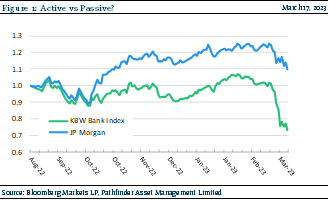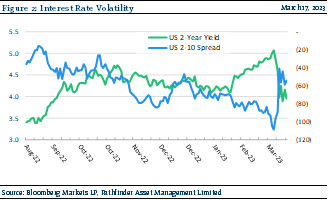A Run on The Bank
While it appears that some investors and bank regulators had previously spotted potential issues at Silicon Valley Bank (SVB), the speed the bank failed took everyone by surprise. After less than a week of uncertainty, the US Fed has taken over the company, guaranteed deposits and prudently provided a facility to backstop the banking system.
- Essentially, all SVB clients asked for their deposits back. This happened because the type of clients (start-ups) need their money as part of their regular business operations (i.e. net withdrawals). SVB made some poor investment decisions and when they needed more capital, investors would not provide it.
- SVB was a “top 20” US bank with $220 billion in assets. Before bank regulations were changed during the Trump administration, it was much smaller – approx. $50 billion. It became the fastest growing bank in the US when those regulations were relaxed.

- 95% of the bank’s customers were not insured (>$250,000 balance). This is different for large banks, where approximately 50% of their clients are uninsured and they have a very broad customer base. Furthermore, this is a huge concentration risk driven by a small number of very large customers.
- SVB was a very “high touch” business that was expensive to run, so they pushed their investment portfolio hard. The bank bought nearly $100 billion of long duration bonds at essentially the top of the market. When US 10yr bonds went from 0.5% through 4% in a matter of months, the firm lost billions, wiped out investor capital and caused the 2nd largest bank run in US history. This forced the government to take the company over to protect depositors.

“This means that” we continue to believe that it is very important for investors to be active. We own large Canadian and US banks in our mandates, but they are broadly diversified, well capitalized and highly regulated. In our case, this has made the businesses we own stronger. They have been able to acquire billions in deposits from the smaller regional firms. Understanding what you own and why you own it becomes critical during stress periods like this.
National Instrument 31-103 requires registered firms to disclose information that a reasonable investor would expect to know, including any material conflicts with the firm or its representatives. Doug Johnson and/or Pathfinder Asset Management Limited are an insider of companies periodically mentioned in this report. Please visit www.paml.ca for full disclosures.
Changes in Leverage. We are increasing the asset ceiling to 2.0 times the market value of equity for Pathfinder International Fund and Pathfinder Real Fund to be consistent with Pathfinder Partners’ Fund and Pathfinder Resource Fund.
*All returns are time weighted and net of investment management fees. Returns from the Pathfinder Partners’ Fund and Partners’ Real Return Plus Fund are presented based on the masters series of each fund. The Pathfinder Core: Equity Portfolio and The Pathfinder Core: High Income Portfolio are live accounts. These are actual accounts owned by the Pathfinder Chairman (Equity) and client (High Income) which contain no legacy positions, cash flows or other Pathfinder investment mandates or products. Monthly inception dates for each fund and portfolio are as follows: Pathfinder Core: Equity Portfolio (January 2011), Pathfinder Core: High Income Portfolio (October 2012) Partners’ Fund (April 2011), Partners’ Real Return Plus Fund (April, 2013), and Partners’ Core Plus Fund (November 2014).
Pathfinder Asset Management Limited (PAML) and its affiliates may collectively beneficially own in excess of 10% of one or more classes of the issued and outstanding equity securities mentioned in this newsletter. This publication is intended only to convey information. It is not to be construed as an investment guide or as an offer or solicitation of an offer to buy or sell any of the securities mentioned in it. The author has taken all usual and reasonable precautions to determine that the information contained in this publication has been obtained from sources believed to be reliable and that the procedures used to summarize and analyze such information are based on approved practices and principles in the investment industry. However, the market forces underlying investment value are subject to sudden and dramatic changes and data availability varies from one moment to the next. Consequently, neither the author nor PAML can make any warranty as to the accuracy or completeness of information, analysis or views contained in this publication or their usefulness or suitability in any particular circumstance. You should not undertake any investment or portfolio assessment or other transaction on the basis of this publication, but should first consult your portfolio manager, who can assess all relevant particulars of any proposed investment or transaction. PAML and the author accept no liability of any kind whatsoever or any damages or losses incurred by you as a result of reliance upon or use of this publication.